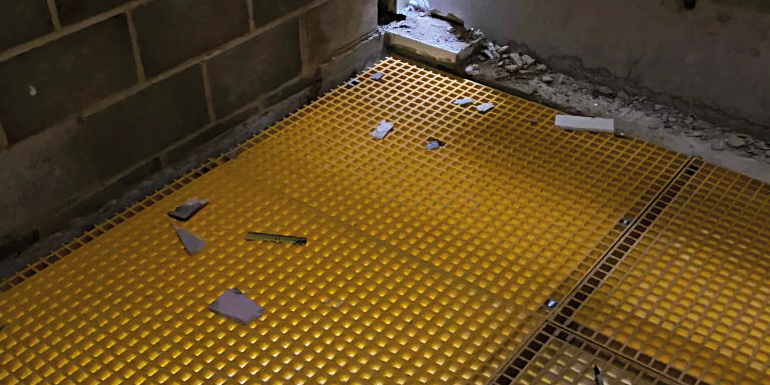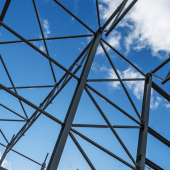Riser shafts: the forgotten area of HRBs

All eyes are on preventing falls, but the role of riser shafts in reducing fires is woefully misunderstood, say Ambar Kelly’s Alex Bardett and Nick Atkinson.
With the Grenfell Tower tragedy bringing fire safety in higher-risk buildings (HRB) sharply into focus, understanding the role of risers is vital. Risers are a dedicated space for the distribution of utilities and essential services including water, gas and electricity, as well as waste pipes, ventilation, air conditioning and multimedia cables. They run vertically through a building or along an incline between different floors and levels, and feature a series of hatches and doors that allow access for maintenance.
This vertical passage connects every floor in the building and is essentially a chimney. The Grenfell tragedy itself involved the chimney effect of the cavity in between the cladding and the main structure of the building, enabling the fire to spread. The King’s Cross station fire of 1987 is another example that involved a shaft ‘trench effect’, when a discarded match lit a combustible material and the fire rose in the ‘trench’ of the wooden escalators.
At the Tall Buildings Fire Safety Conference in December, Ambar Kelly’s Director Nick Atkinson noted that riser shafts are often concealed once buildings are completed, so the issue can remain a blind spot in construction and mask the ongoing threat. This is made worse, he said, by the fact that “75% of the tall buildings under construction in London are using [glass-reinforced plastic] GRP riser floor products made from Euroclass C combustible materials. While these products prevent falls, they overlook the severe risk of smoke and flame spread.”
So, what steps can be taken to avoid this chimney effect in buildings?
Slips, falls and fires
A riser shaft starts its life as a series of holes; one floor above the other, walls are installed around the holes, then they are filled in with the necessary mechanical, electrical and plumbing services required to serve the building. Once the services are installed, they are closed off with doors, but before this happens there is a fall from height risk that must be mitigated.
This risk from falls and slips can be mitigated by adopting GRP grating and installing temporary or permanent floors in the riser shaft. One of the most common and effective materials for riser shaft floors is GRP grating as it is non-slip and non-conductive, but there is a problem with this material that we will come back to.
Because riser shafts also play a vital role in fire safety, they require fire-rated materials and proper sealing to prevent the spread of fire and smoke between floors. There are strict health and safety regulations for riser shafts set out in the UK government’s Approved Document B to mitigate the spread of fires. It states they must be walled in to create a protected shaft designed to stop fire and smoke from spreading outwards onto the floor of a building or from one level to another.
And with the threat of a fire trench forming, the materials themselves become all-important. Non-combustible steel plate materials, featuring pre-cut holes for mechanical and electrical services that are covered by a lid, are preferable but often seen as too expensive. While it is true the initial cost will typically be more, that cost will not increase as the project progresses.
GRP grating riser flooring options are cheaper, but that cost will increase over time due to post-installation works. For example, GRP grating has to have holes cut into it to account for any services being fed through. Temporary fire doors will need to be fitted on every floor to meet codes of practice and prevent the spread of fire during construction as grating, by its very nature, allows smoke and flame to pass through. This increases the overall project cost in the long run.

Non-combustible steel plate materials, featuring pre-cut holes for mechanical and electrical services that are covered by a lid
Fire ratings and combustibility
From March 2025, the Ministry of Housing, Communities and Local Government confirmed that the national British Standard BS 476, which relates to reaction and resistance to fire and roofs, has begun to be phased out from Approved Document B and will be removed completely by September 2029. Additional updates include Parts 6 and 7, which will require construction products to be classified in accordance with EN13501-1, with performance classes A1 and A2 for non-combustible products and B, C, D and E for combustible products. The Grenfell Tower Inquiry found this surface spread of flame test (BS 476 Part 6 and 7) does not measure combustibility, which why it is being phased out.
However, products are often labelled as having a fire rating – that does not mean they are not combustible. Specifiers will often see suppliers promoting products that have a BS 476 Part 6 and 7 fire rating, which is actually a measure of the spread of flame. This is typical for GRP grating used by UK contractors as a riser flooring solution.
Throughout the construction industry, it is widely believed that GRP is non-combustible as it is labelled fire-resistant. But all GRP grating is combustible – it is woven glass fibre strands bound together with various resins that are derivatives of crude oil – and will add fuel to any fire that occurs in a riser shaft. Moreover, a shaft will exacerbate a fire, and the combustible nature of GRP could turn a simple cellulose-based fire into a much fiercer hydrocarbon fire.
Regulation changes focus on fire testing and certification, but more education is needed on modular riser flooring and non-combustible products.
If the designed product for riser flooring in an HRB is specified as non-combustible at Gateway 2, contractors may believe the GRP grating has the required fire rating and attempt to hand the project over to Gateway 3. Despite it having a BS 476 Part 6 or 7 declaration, it is combustible, meaning it will likely be rejected.
The (lack of) responsibilities and the product chain
Mistaken assumptions of responsibility (or lack of) can mean a contractor will be under the impression that the product’s supposed fire rating is correct, handing over the project to the next person in the chain. Indeed, there are occasions when a main contractor will say: “The sub-contractor has bought it and said it’s fire-rated, so it’s not my problem.” Unfortunately, the main contractor will often hold all the risk and they will not even realise it.
Atkinson points out that the present approach to riser flooring has no single point of responsibility. “The risk of fire through a shaft during construction is often not added to the risk register to manage. This is against Construction Design and Management Regulations 2015 (General Principles of Prevention), page 8 section 5a: ‘Avoid risk in design where possible’.
“The Principal Contractor is least of all concerned with flooring design in a riser; their attention is on the risk of falling from height, as this presents the immediate risk during the construction of the structural frame. They perceive falling from height to be the responsibility of the subcontractor … the subcontractor’s solution to the fall from height risk is affected by their desire to stay within budget.
“The subcontractor building the structural frame therefore essentially becomes the designer and installer of the temporary riser protection, with the Principal Contractor then promoting this as the permanent riser flooring.”
If a non-combustible class A1 steel riser flooring product is specified in Gateway 2 and replaced by a combustible Class C GRP product, this needs to be recorded in the change control plan so the impact of these combustibility changes can be considered by the relevant teams. Furthermore, it must be documented before the Building Safety Regulator signs off the building for handover at Gateway 3.
While it is essential that contractors know their responsibilities if they change a specified non-combustible product for a cheaper combustible alternative, suppliers also play a huge role. Their products must be tested and certified to EN13501-1 to allow design teams and contractors to make an informed comparison between products.
This is why education is key. Helping suppliers and main contractors understand the benefits of non-combustible materials will go a long way towards improving fire safety in the built environment. “While the updated fire safety regulations are attempting to improve accountability and encourage those in the industry to utilise non-combustible materials, often specifiers will choose outdated and combustible alternatives due to a lack of understanding and misconceived ideas of cost-effectiveness,” Atkinson notes. All contractors need to understand that GRP is combustible.
Non-combustible materials not only ensure greater fall protection for those working in the riser shaft, but also act as a horizontal fire break to significantly reduce the spread of fire and smoke.
As Atkinson comments: “It’s down to everyone in the industry to ensure that the hidden risks of risers are exposed and increase awareness of the importance of non-combustible solutions – with the overall aim of enhancing the safety of contractors and occupants.”
For more, visit b.link/FPA_risershafts
Read Approved Document B at b.link/GOV_DocB







